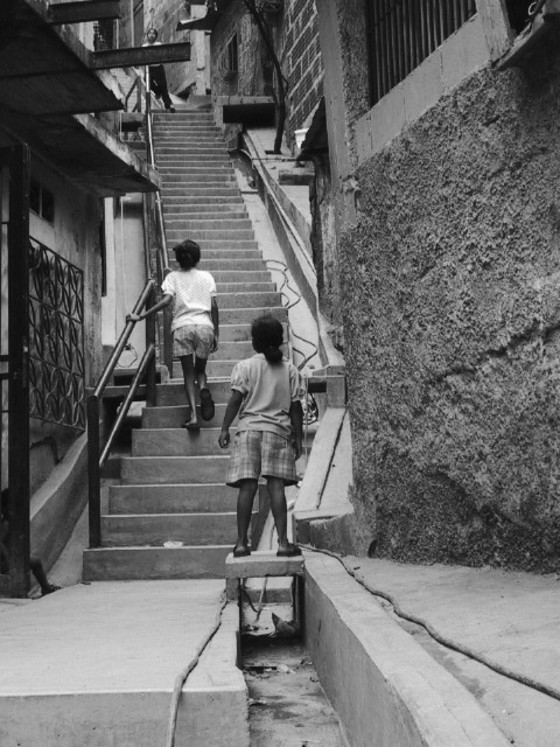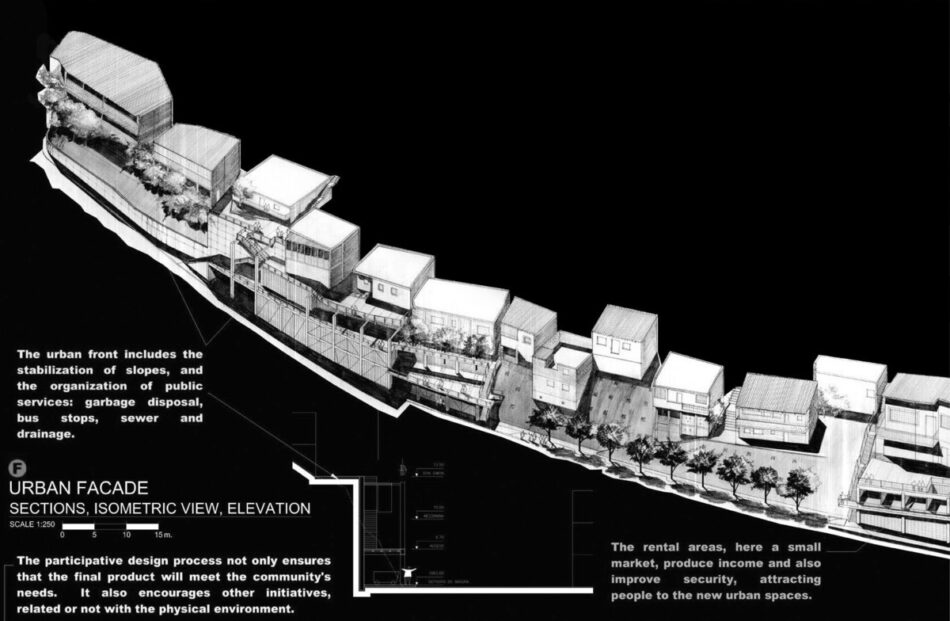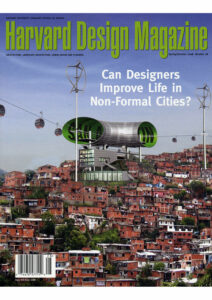Improving Informal Settlements: Ideas from Latin America
United Nations estimates suggest that nearly one billion people now live in slums worldwide—one-sixth of the planet’s population. Without concerted action, the number is expected to double by 2030. Categorical terms like slum, however, can disguise significant cultural and economic distinctions among low-income settlements. Variously known as informal or non-formal cities, squatter settlements, or shantytowns, these communities differ dramatically in size, character, age, and level of political and social organization; they are found in both rural and urban areas, although they are increasingly associated with the world’s largest cities, especially in Latin America, Africa, and Asia. Informal urban settlements appear in city centers and on their peripheries; they result both from traditional squatting and from a kind of “pirate urbanism”: they don’t conform to zoning or service regulations and are enabled by bribes, populist governments, or property speculators who hope for eventual regularization and compensation for their investment. Notwithstanding their variations, however, these places share some characteristics: inadequate housing, insufficient living space, insecure land tenure, and lack of access to basic services, especially clean water and sanitation.
In recent years, prevailing strategies for addressing non-formal settlements have shifted away from large-scale slum clearance and relocation, which have been demonstrated to cause massive social disruptions. The approach favored today is on-site upgrading and improvement, with the goal of integrating low-income communities into their larger urban contexts. There may be something inevitable about this: there are so many informal settlements around the world and many of them are so big and so old that it is becoming impractical to think of removing them entirely, especially since sufficient vacant land is scarce. Improving informal settlements, though more cumbersome and arguably more expensive than building right in the first place, has the advantage of leaving intact the economic and social networks that residents have created for themselves. As yet, however, there is no clear set of best practices for these upgrades, which range from small “acupunctural” insertions to expansive infrastructural improvements, from familiar government-led programs to designer-initiated projects.
The work presented in the pages that follow suggests the various ways that contemporary designers in Latin America are attempting to upgrade informal settlements physically without destroying them socially, saving what they can of their physical structure while alleviating environmental and social problems ranging from inadequate public space and housing to unemployment, insecure land tenure, and poor sanitation. The selection uses landscape as the particular lens through which to examine these settlements: their occupation of marginal lands, including floodplains, ravines, and steep slopes; their proximity to damaged or toxic sites, including sewage canals, industrial facilities, and landfills; their typical separation from urban landscape infrastructure, whether roads, transportation, sewers, water supply, or storm-water management; their severe environmental, public health, and security problems; and their lack of public facilities for economic, cultural, or recreational activities. Landscape is conceived both as the primary problem in these communities and as the main opportunity for intervention and improvement. Built work and proposed projects by both recognized and emerging designers are included in this selection.
Why focus on Latin America? Beyond geographical and cultural coherence and shared colonial and postcolonial histories, there are several reasons to focus on this region. Primary is the fact that some of the world’s most interesting current efforts to improve the conditions of non-formal cities are occurring there. The restoration of civilian rule in some countries and the rise of populist governments in others have moved the plight of the poor forward on the political agenda. Growing economies have provided improved financial means to consider community-improvement programs, despite significant and in many places widening gaps between the rich and the poor. Many of Latin America’s largest cities, including Mexico City, Buenos Aires, São Paolo, and Rio de Janeiro, have among the world’s largest urban GDPs when measured by “purchasing power parity” exchange rates. At the same time, Latin America has some of the world’s highest “Gini coefficients,” which measure disparity in income and wealth distribution. Squatter settlements in Latin America would thus seem to be as much an expression of inequality as of absolute poverty. And although this region has some of the world’s highest rates of urbanization, slum growth today in many parts of the continent is slowing, according to the UN-Habitat report, State of the World’s Cities 2006/7.1 Settlements are consolidating, and many countries are beginning to provide residents with access to land tenure and services. All in all, Latin America represents a laboratory for slum upgrading that might provide a model for other parts of the world.
What can we learn from this work? To begin with, we need to acknowledge the difficulties of generalizing about it. Differing topographies, social and economic conditions, cultural traditions, and levels of physical development all require different strategies. Moreover, some communities are safe to work in; others are zones of conflict between police and drug dealers that make it all but impossible for designers to work. The strong involvement of government at all levels facilitates improvements in some countries, such as Brazil. Charismatic leaders can catalyze efforts in others—as in the Colombian cities of Bogotá and Medellín. In some places, however, the relative absence of government leadership makes upgrades more problematic; in those cities, designers are taking a more activist or entrepreneurial approach, generating theoretical projects or funding their own initiatives, often in conjunction with non-governmental and community-based organizations.
In any event, working in the informal sector requires designers and their critics to focus as much on process as on product, since there is often more complex thought in these projects than is evident in the final built work. The efforts of the Caracas firm Arqui 5 are emblematic of this fact: they developed elaborate and well-conceived plans for upgrading the entire San Rafael-Unido neighborhood—part of the vast La Vega barrio—including a new “urban facade” that would provide slope stabilization while offering commercial development, a preschool, apartments, and a community center. The project won a gold medal from the Holcim Foundation for Sustainable Construction in 2006, but only several sets of stairs linked with small public spaces were actually built. Construction of the community center was halted midway—mostly because of political gridlock.2 The project was notable for community involvement in the design process—75% of residents had to approve (in writing) the upgrades—but it also reveals the importance of engaging all the stakeholders in a community, from neighborhood associations and community-based organizations to the highest levels of government. In the absence of someone to build consensus, designers might be forgiven for finding this too time-consuming and demanding—not to mention professionally and financially unrewarding.
This is to say: We need to recognize the many ways that this work can be problematic. It addresses numerous economic, environmental, infrastructural, and social failures of recent urban policies; it often involves the messy procedures of community design and the compromises of political action. At the same time, it is arguably complicit in neoliberal policies that favor small self-help initiatives, micro-enterprises, and market-based solutions over more ambitious, state-sponsored programs that might have a larger impact. In addition, it is not yet clear whether upgrading can achieve significant permanent improvements or will merely perpetuate social and spatial inequalities, with large percentages of the population packed into disproportionately small areas with still limited services.
Moreover, upgrades to informal settlements are invariably partial, provisional, and experimental. They rely on the idea of replicability: solutions developed for one site can be used at another. But given the scale of informal settlements and their considerable variation, can success be measured by the mere potential for replication, or should projects be considered beneficial only when replicability is proven? Many of these projects depend on the notion that small-scale improvements will inspire other, larger upgrades, both individual and public. This theory might be dependable in the formal city, but it has yet to be proven valid for informal contexts, where anxiety about tenure and safety will surely hinder subsequent investments. Significant improvement in low-income communities can be achieved only through a combination of small-scale, local initiatives and massive upgrades to sanitation, transportation, and employment infrastructures, which have to be orchestrated at the national and international levels. Absent the larger initiatives, the small-scale insertions might legitimately be criticized as appeasements more than substantial improvements.
We need to continue to question the assumptions upon which this work is based. For instance, is it really appropriate to introduce elements of the formal city into the non-formal context? Is public space as conceived in the formal city relevant to informal settlements? Or should it be reconceptualized? Passive recreation of the sort that characterizes landscapes in the formal city is not a priority in informal contexts. Public space can even be considered dangerous: In San Rafael-Unido, residents conveyed to Arqui 5 their anxieties that new public space would simply provide more opportunities for vagrants and drug dealers. Facilities for active recreation are generally more suitable to informal settlements than spaces for passive occupation, especially in places with large populations of teenagers with limited educational and employment opportunities. But we might have to push our conceptions of public space even beyond this, to a notion of productive space, including market facilities, community kitchens and laundries, and places for cultural expression—like Rio’s samba schools. And we need to think about long-term maintenance and community identification with upgrade projects. Facilities that don’t inspire a sense of community ownership are soon degraded or vandalized. Spaces that generate economic benefits typically inspire a keener support, as do projects that contribute to environmental improvement in some way, like river cleaning or reforestation programs.
Whatever the problems and limitations of these upgrading initiatives, given the current economic and political climate, they might be a designer’s most viable mode of practice in the non-formal city. There is certainly much to admire in this work. Particularly laudable is the fact that its focus mostly has shifted away from simple, one-dimensional projects toward programs that address multiple conditions and needs. Whereas designers and public officials might once have thought just in terms of improved housing, many now recognize that providing housing by itself isn’t an adequate response: It has to be paired with improvements in transportation, job training, health, and safety. In Bogotá, the focus has been on equalizing rights to the city through improved facilities and circulation within barrios and express-bus links from the barrios to employment and recreation opportunities in the formal city. In São Paolo, the emphasis has been on sanitary upgrades to settlements surrounding the city’s reservoirs to improve public health in both formal and informal communities. Overall, it is increasingly apparent that landscape is a crucial element in these projects: Upgrading is less a matter of individual buildings than of creating habitable environments and improved urban ecologies.
Where do we go from here? We have two chief areas of concern. One is the severe competition between the expansion needs of informal cities and the protection of ecological and economic resources like farmlands, wetlands, and preservation areas. Witness, for instance, the squatter invasion of the forested slopes of Tijuca National Park in Rio or of the fertile farmlands around Bogotá. How are we to balance a growing population’s right to shelter with the aims of environmental management? Our second concern is about the wisdom of conventional upgrades during a time of climate change: If we bring electricity to hundreds of millions of slum dwellers, for example, should it come from coal-fired plants? Or can we skip antiquated technologies and make low-income settlements models of sustainable development? Already they have smaller environmental footprints than formal cities: They are denser and more walkable with fewer cars and more public transportation. Can the best qualities of these places be retained, even as they are upgraded? We need to work in anticipation of future conditions and constraints.
From the perspective of professional practice, can design work in these communities become self-sustaining? Much of the work is now pro bono. But can and should some other model be developed? When federal programs and international lending agencies are involved, the work can be remunerative. Absent that, it is fair for designers to wonder if they will ever be adequately compensated for their time and effort, especially given the amount of political and community-contact work that is often required. Pedagogy needs to be retooled as well, to shift more educational focus from the formal to the informal, from the developed world to the developing, especially those areas in Africa and Asia where growth in the informal sector is highest.
Our thinking here is exploratory, raising questions more than providing answers. As difficult and complex as conditions are in low-income communities, they provide clues to their own improvement: Residents of non-formal cities often display cultural adaptations and survival strategies that can guide future interventions. Designers are beginning to be able to give spatial form to the environmental, social, and economic ambitions of these communities, helping to marshal the financial investment and political will to begin their transformation. In sum, this work explores the relationship between social ethics and creativity in design culture. It advances the hopeful thesis that impoverished contexts do not have to result in a poverty of imagination. No one project is perfect and complete in itself; many are flawed. The important point here is to get the ideas out in the hope of starting to define best practices. Apart from climate change, there are few greater challenges to widespread planetary health and security than the vast proliferation of non-formal settlements. And, as with addressing climate change, there is no time to waste.


We want to express our appreciation to our students over the past three years, who have helped us greatly with our research into informal communities. We are particularly grateful to the members of KDI, especially Jennifer Toy and Chelina Odbert, whose experiences in the Kibera settlement in Nairobi have helped shape these remarks.
